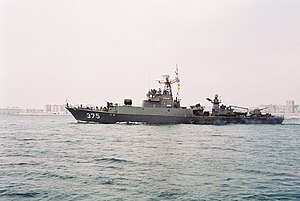Parchim-class corvette

Indonesian corvette KRI Cut Nyak Dien
|
|
| Class overview | |
|---|---|
| Name: | Parchim class |
| Builders: | Peenewerft, Wolgast, East Germany |
| Operators: | |
| Built: | 1985-1989 |
| Completed: | 24 |
| Active: | 24 |
| General characteristics | |
| Type: | Anti-submarine corvette |
| Displacement: | 800 tons standard, 950 tons full load |
| Length: | 72.50 m (237 ft 10 in) |
| Beam: | 9.40 m (30 ft 10 in) |
| Draught: | 4.60 m (15 ft 1 in) |
| Installed power: | 14,250 hp (10,630 kW) |
| Propulsion: | 3 shaft M504 diesels |
| Speed: | 24.7 knots (45.7 km/h) |
| Range: | 2,100 nmi (3,900 km) at 14 knots (26 km/h; 16 mph) |
| Complement: | 80 |
| Sensors and processing systems: |
|
| Armament: | |
The Parchim-class corvette (Soviet designation Project 1331M) was developed for the East German Navy in the late 1970s, and built by the Wolgast Peene-Werft. The ships were designed for coastal anti-submarine warfare. In case of an all-out NATO-Warsaw Pact war in Europe their prime targets would have been the small U-206 coastal submarines of the West German navy. The first ship, Wismar (now the Indonesian KRI Sutanto), was launched on 9 April 1981 in , and subsequently another 15 ships were built until 1986. To make production more economical, the Soviet Union agreed to purchase another 12 ships from Wolgaster Peenewerft built between 1986 and 1990, thereby effectively subsidising the East German shipbuilding industry.
The ships of the Soviet Navy were named Parchim II by NATO. Though useful as a coastal ASW platform, the Soviet production of the similar but far more powerful Grisha class made this purchase even more illogical for the Red Navy. After German re-unification the former East German ships were sold to the TNI-AL (Indonesian Navy) in 1993. The Indonesian Navy extensively refurbished their Parchims, to the point where the refurbishing exceeded the cost of purchase. They are still in service, both in the Indonesian Navy and in the Russian Baltic Fleet.
The Parchims were built to replace the obsolete HAI III-class subhunters of the Volksmarine. Because of their displacement, over 800 tons in full load, they were able to leave coastal waters, even in rough weather. Propulsion consisted of 3 Soviet-designed M 504 56 cylinder diesel engines, a development of the M 503 A fast attack craft engine. The middle engine provided power to a variable-pitch propeller for cruising speed, while the two outer engines served two outer fixed-pitch propellers for boost speed. Total power output was 14,250 hp (10,630 kW). The ships were constructed with regular (stainless) steel and consisted of ten waterproof compartments.
For air defence, the ships were equipped with one double-barrel AK-230 30 mm gun and one double-barrel AK-725 57 mm gun. The Ak-725 double 57 mm AA gun, designed in 1959, was directed by the ESP-72 fire control system, which received ranging and target bearing information from an MR 103 (NATO codename 'MUFF COB') radar. The MR 103 had a 1.30 m (4.3 ft) parabolic radar dish, with an optical camera system slaved to it, as a backup system in case of failure or heavy EW environment. The barrels of the gun were water-cooled and belt-fed, with each belt containing 550 rounds, but the first round had to be manually chambered. In an emergency, the turret could be manually operated with an optical fire control system. The MR 103 radar system, already outdated when the Parchims were developed, used 1950s-style electromechanical systems, built around vacuum tubes. As a result, it wasn't considered to be an effective anti-missile system, or CIWS (Close-in weapon system), as was evidenced by a Soviet training accident in 1987 when a test missile drone accidentally locked in on a small Soviet Navy training vessel. Although the ship's AK-725 system kept firing until the moment of impact, no hits were scored and the ship was destroyed by the resulting fire, allegedly killing 39 crew members.
...
Wikipedia
